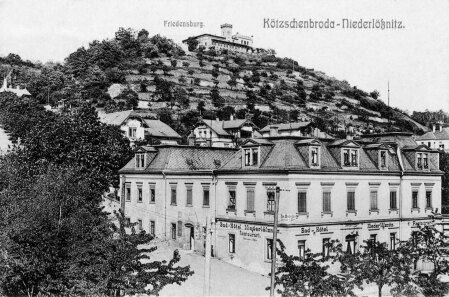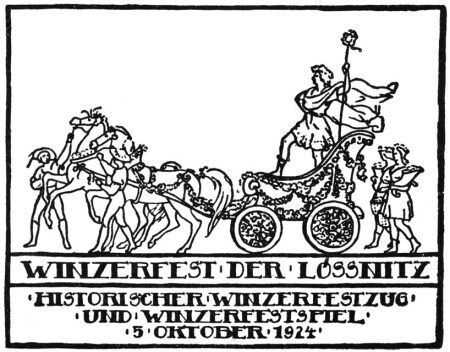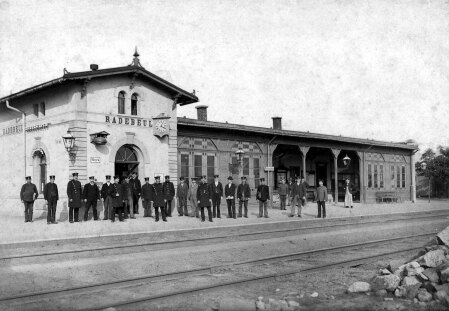Historical foray
Radebeul was granted town charter on 1 April 1924, making it a relatively young town.
The development of the original municipalities began many centuries earlier. Today's urban area comprises ten formerly independent municipalities. The municipality of Radebeul, which gave the town its name, was a rather small and inconspicuous village with 12 farms (today: Alt-Radebeul - Am Kreis town centre), which was first mentioned in a document in 1349.
The largest Lößnitz village was Kötzschenbroda with 60 farms, which first appears in written records in 1271. The armistice between Sweden and Saxony was signed here on 27 August 1645 in the run-up to the Peace of Westphalia. The autumn and wine festival that takes place here every year gives an idea of the flair that Altkötzschenbroda exudes.
The earliest record of the existence of a Lößnitz village dates back to 1144, meaning that Naundorf is mentioned earlier than Dresden. You can still experience the village centre in all its originality today. Especially during the village and school festival, which takes place every two years, old wine cellars invite you to sample Saxon wine.
Zitzschewig is located in the immediate neighbourhood of Naundorf. During the First World War, this place name is said to have often been used as a slogan, as it was difficult for the English and French to pronounce correctly due to the many sibilant sounds.
Lindenau is the second smallest village in the urban area, where mainly winegrowing families lived and made a modest living in the neighbouring vineyards. The village was known for having many children, with 25 children per 100 inhabitants. It will therefore come as no surprise to anyone that nobody agreed to bear the high "school fees" when the village was later united.
Serkowitz is the nearest community to Radebeul, situated directly on the Elbe. On 18 October 1784, a hunting party of Elector Friedrich August drove along the old Meissen post and country road (today: Kötzschenbrodaer Straße), which had been washed away by the Elbe. There would inevitably have been an accident if two farmers' wives had not warned them of the danger.
Wahnsdorf, which is mainly known for its meteorological observatory, is located a little further away on the plateau. There is also an interesting architectural monument to be seen in the Wahnsdorf area, the former Bilz sanatorium.
The smallest community was established around 1550, completely enclosed on Kötzschenbroda land, on the former estate of the Elector and was therefore given the name Fürstenhain. This small village with only 8 houses only existed for a short time. It was incorporated into Kötzschenbroda as early as 1876. Fürstenhainer Straße is all that remains of this place today.
The creation of two new Lößnitz communities on the land of the existing villages is another special feature of Radebeul
This development was essentially shaped by the characteristic landform of the Lößnitz, the vineyards. They greet the visitor from afar, so that one feels transported to southern climes. For this reason, Radebeul has recently become known as the "Saxon Nice".
The farmers' vineyard estates were located far away from the actual town centre. In the 16th/17th century, these vineyards changed hands more and more frequently. Nobles, but also wealthy citizens, especially from neighbouring Dresden, found it simply chic to grow their own wine and serve it to their guests. This happened to a great extent after the end of the Thirty Years' War and began with the construction of the Hoflößnitz by the Saxon Elector in 1650.
Further manor houses were built, which served as summer residences for the new vineyard owners. These pretty villas are now listed buildings and were lovingly renovated by their owners after reunification. The villa owners then spent the winter back in their townhouses. Some of them may have stayed in the Lößnitz during this time, resulting in the development of new villa estates, which increasingly became permanent residences. Taxes continued to be paid at the main place of residence. This led to recurring disputes with the local farmers. The financial burden on the villages increased. The poor had to be provided for, night watchmen expected their wages and schools had to be built and maintained as the population grew rapidly. A temporary solution was found in Oberlößnitz in 1822 with the establishment of a "Communal Association of Vineyard Owners" and in Niederlößnitz in 1832 with the "Niederlößnitzer Weinbergsverein". This peculiar situation came to an end with the new Landgemeindeordnung of 1838. On 1 January 1839, the two associations were effectively forced to assume all the rights and duties of a proper municipality. Thus 8 suddenly became 10 Lößnitz villages. Oberlößnitz and Niederlößnitz were created - another speciality of Radebeul.
50 years later, efforts to unite the Lößnitz municipalities began. This was due to the rapidly growing population and other economic constraints. This development was accelerated at the beginning of the last century when Dresden incorporated many previously independent neighbouring towns. The Lößnitz villages escaped this fate when the two towns of Radebeul and Kötzschenbroda merged in 1935, after the eastern and western Lößnitz villages had already merged in stages. This step proved to be a clever political move for the further development of the town, so that Radebeul was finally named a "Große Kreisstadt" in 1995 and was spared from being incorporated into Dresden.
That was a brief introduction to the history of the town of Radebeul, which does not at all correspond to the classic image of a town with a church and a market square, but it is precisely this diversity that gives it its unique charm. Even today, the inhabitants of Radebeul attach great importance to the neighbourhood in which they live. Last but not least, festivals and celebrations to mark the first mention of the town's districts are evidence that these local historical traditions have not been forgotten and will continue to be upheld.

© Stadtarchiv Radebeul
Badhotel

© Stadtarchiv Radebeul
Winzerfest

© Statarchiv Radebeul
Bahnhof Radebeul



